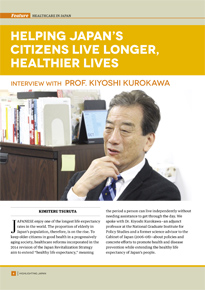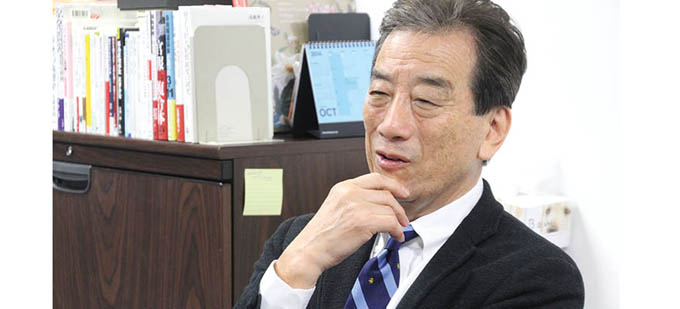Home > Highlighting JAPAN >Highlighting Japan November 2014>Healthcare in Japan
Highlighting JAPAN

Helping Japan’s Citizens Live Longer, Healthier Lives
Interview with Prof. Kiyoshi Kurokawa

Japanese enjoy one of the longest life expectancy rates in the world. The proportion of elderly in Japan's population, therefore, is on the rise. To keep older citizens in good health in a progressively aging society, healthcare reforms incorporated in the 2014 revision of the Japan Revitalization Strategy aim to extend "healthy life expectancy," meaning the period a person can live independently without needing assistance to get through the day. We spoke with Dr. Kiyoshi Kurokawa—an adjunct professor at the National Graduate Institute for Policy Studies and a former science advisor to the Cabinet of Japan (2006-08)—about policies and concrete efforts to promote health and disease prevention while extending the healthy life expectancy of Japan's people.
![]()
What are the hallmarks of the healthcare system in Japan?
On the whole, Japan’s healthcare system is quite good, providing open access—meaning patients can receive treatment at the hospitals and clinics of their choice, which is not common abroad—and high-quality medical services at low out-of-pocket expense. By leveraging those strengths, Japan is also promoting universal health coverage in developing countries with the idea that all people should receive basic healthcare services.
Foreigners who have received treatment in Japanese hospitals are surprised at the low cost and high quality of medical care here. Even with one in four citizens being 65 years or older and chronic conditions on the increase, medical expenses per capita are low, and Japanese healthcare costs come to just ten percent of GDP, which is on the lower end even compared with other developed countries.
What are the main issues that Japanese healthcare faces?
As the elderly population grows, the numbers of bedridden people and those with cognitive impairment are expected to rise. It is crucial to discover how to extend the healthy segments of their lives, not just for them but also for their caregivers and others close to them, and how to prevent problems like cognitive impairment.
The open access and high-quality services that Japan is so proud of as well as the luxury of low out-of-pocket expenses were all established in the 1960s when medical science and technology were advancing and the Japanese economy was gaining its footing and growing continuously. With the surge in the proportion of elderly in society, however, that structure is an extravagance that can no longer be maintained and must be reconsidered.
What solutions do you think should be proposed for these issues?
One specific implementation of a strategy to lengthen healthy life expectancy is the Data Health Plan. This plan includes projects in which information held by employers’ health insurance societies—such as receipts (medical reimbursement statements) and diagnostic data—are used to help maintain each insurance subscriber’s health or prevent the onset or progression of ill health. Some of the projects will start in 2015, with a view to eventually having plans generated by all health insurance societies.
Digitizing patient information can also make the system more efficient, since the data can easily be shared among healthcare professionals. In addition, giving patients access to and ownership of their personal information raises their awareness toward health, leading to their checking their health status more frequently and adopting preventive measures.
What does the future of healthcare in Japan look like?
In a society that is aging rapidly, illnesses prevalent among older people like cognitive impairment will become increasingly problematic. Japan must get ready for these, and right now it has a lot of loose ends to tie up. Japan may have a high level of scientific research and technology, but it needs to look deeper into other areas such as using big data in health management or innovations in the use of caregiver robots.
Aging populations and rising healthcare costs are common problems across the globe, of course. Japan’s knowhow can therefore serve as a model for other countries and perhaps be employed overseas.
© 2009 Cabinet Office, Government of Japan






